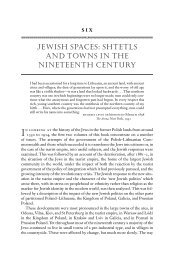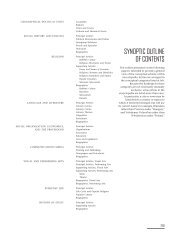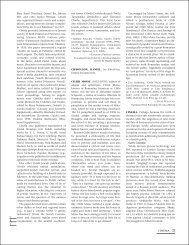t any plant names in Yiddish - YIVO Institute for Jewish Research
t any plant names in Yiddish - YIVO Institute for Jewish Research
t any plant names in Yiddish - YIVO Institute for Jewish Research
Create successful ePaper yourself
Turn your PDF publications into a flip-book with our unique Google optimized e-Paper software.
XVIII<br />
˘È„”È Ôȇ ËÏÚÂÂ≠ÔÒ˜ÈÂÂÚ‚ È„ Ÿ ¯ÚËÎÚ˘ È΄¯Ó<br />
through apltshínes (sabesdiker losn!) and metathetically atta<strong>in</strong>ed<br />
paltshínes, popular etymology has treated us to the follow<strong>in</strong>g gem:<br />
palestínes 'Palest<strong>in</strong>e fruit'!<br />
Among the <strong>names</strong> of <strong>plant</strong>s, <strong>plant</strong> parts, and fruits possess<strong>in</strong>g a bewilder<strong>in</strong>g<br />
assortment of synonyms and variants <strong>in</strong> <strong>Yiddish</strong> ethnobotanical<br />
term<strong>in</strong>ology are also the follow<strong>in</strong>g:<br />
6. Red radishes are variously known as (resh)khóydesh-rétekhlekh,<br />
réte(kh)lekh, shóntse rétekhlekh, róyte rétekhlekh, (resh-khóydesh-)<br />
ríbelekh, róyte ríbelekh, redískelekh (see paragraph on humor<br />
above).<br />
7. 'Turnip' shows up as brúkve, bríkev, brús(h)ke, brútske, krútshke,<br />
grízenes, ribn, váse markhávkes, attest<strong>in</strong>g to the ability of languages<br />
<strong>in</strong> contact to <strong>in</strong>fluence each other.<br />
8. Another illustration of the bewilder<strong>in</strong>g asssortment of <strong>plant</strong> <strong>names</strong><br />
<strong>in</strong> <strong>Yiddish</strong> are the terms <strong>for</strong> sorrel. Harkavy, <strong>in</strong> two of his early dictionaries<br />
(1898a, b), refers the reader from shtshav to shtshavéy<br />
'sorrel'; he lists only shtshavéy <strong>in</strong> a third dictionary (1900). In the<br />
last of his dictionaries (1925), after <strong>in</strong>corporat<strong>in</strong>g all of Lifshits's<br />
lexical items, Harkavy lists shtshav and shtshavéy as synonyms,<br />
as well as Lifshits's kvaséts. 5 He does not list the Central <strong>Yiddish</strong><br />
('Polish <strong>Yiddish</strong>') v<strong>in</strong>tage shtshuf and khtshuf, let alone the rarer<br />
<strong>for</strong>ms listed below.<br />
The Thesaurus of the <strong>Yiddish</strong> Language (Nokhem Stutshkov 1950:<br />
223) is more <strong>in</strong>clusive: shtshav, shtshávye, shtshavél, shtshavéy, tsvey,<br />
and kvaséts, but it too omits the Central <strong>Yiddish</strong> shtshuf, khtshuf, tshákhets<br />
(Erlikh 1982: 143), and the archaic ámper. We<strong>in</strong>reich's dictionary (1968)<br />
lists shtshav exclusively, the most commonly used term <strong>in</strong> American <strong>Yiddish</strong>,<br />
correspond<strong>in</strong>g to both Polish szczaw and Ukra<strong>in</strong>ian s˘c˘av. Tsan<strong>in</strong>'s<br />
dictionary (1982) is the only one that does not omit shtshuf (etymologically<br />
rendered as shtshov); <strong>in</strong>deed, it is the sole <strong>for</strong>m he lists.<br />
a. In belles-lettres, shtshuf/khtshuf occurs <strong>in</strong> the works of M.<br />
Bursht<strong>in</strong>, Y. Emiot, B. Glazman, S. Horontshik, Khayim Krul, Y.<br />
Opatoshu, and Y. Perle (Schaechter 1986 a: 172-173, 283).<br />
b. In the ma<strong>in</strong>ly Soviet <strong>Yiddish</strong> competition between the variants<br />
shtshávye and shtshavél (as <strong>in</strong> hózn-shtshavél), shtshavl and<br />
shtshavéy, the latter seems to have ga<strong>in</strong>ed the upper hand and<br />
has thus been standardized – at least <strong>for</strong> Soviet <strong>Yiddish</strong> – <strong>in</strong> the<br />
Russian-<strong>Yiddish</strong> Dictionary (Shapiro et al. 1984) along with<br />
shtshav.<br />
Not recorded <strong>in</strong> <strong>any</strong> dictionary are shtsha, tshákhets, shtshave<br />
(Malt<strong>in</strong>ski), shtsháver (Kolodni).<br />
5) Actually, kvásets does not refer to Rumex acetosa, but to another species, Rumex acetosella.
















